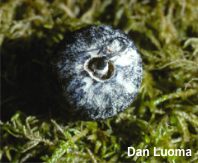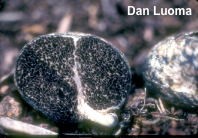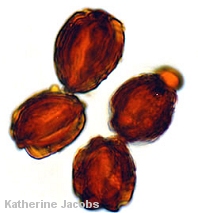| Major Groups > Oddballs & Misfits > Gastroid Gilled Mushrooms & Boletes > Leccinum caespitosum |

|
Leccinum caespitosum [ Basidiomycota > Boletales > Boletaceae > Leccinum . . . ] by Michael Kuo Among the many truffle-like, sequestrate mushrooms found in western North America, this species can be recognized by the presence of a "columella" (central tissue forming a stem that never—or barely—happened); the brown color of the mature spore mass; the blue bruising of the outer tissues and the columella; and, under the microscope, the longitudinally ribbed spores. Additionally, there is a stubby pseudostem created by the columella, and the outer surface is initially whitish before it becomes stained blue. Believe it or not, this mushroom, formerly known as Chamonixia caespitosa, is a species of Leccinum, according to its DNA. Results from a series of studies over the last decades support the idea that several genera of truffle-like, sequestrate mushrooms—Chamonixia, Octaviania, Rossbeevera, and Turmalinea—are best treated as Leccinum species. Although these genera represent distinct groups within Leccinum, they are "nested" inside the bolete-like Leccinum species, leaving taxonomy with a choice: do we keep the "old" genus names for the truffles and, out of necessity, create a bunch of other new genus names for the boletes (because you can't have a genus that exists within another genus!) . . . or do we lump everything together and, by rule, use the oldest genus name in the group, which is Leccinum? The funky names for funky mushrooms are admittedly cool—especially Chamonixia, named for the proximity of the original type collection to Chamonix, on the slopes of Mt. Blanc in France. But having cool names is not as important as reflecting evolution, which is the point of taxonomy, and "use of the genus name Leccinum for sequestrate leccinoid fungi provides instant recognition of the shared evolutionary history in a way that is accessible to nonspecialists and the general public; this evolutionary story is lost when obscured by a proliferation of genus names" (Kuo & Ortiz-Santana 2020). Description: Ecology: Mycorrhizal with conifers (especially hemlocks, Douglas-fir, spruces, and firs); growing alone or gregariously, usually partially submerged in the soil or completely underground; spring through fall; montane western North America, the Appalachian Mountains, and the European Alps. Fruiting Body: 1.5–3 cm across; round or nearly so; outer surface whitish at first, bald or a little silky, bruising blue and eventually becoming brown overall; pseudostem present as a tiny, stublike extension; interior composed of oblong chambers that are initially whitish but turn dark brown with maturity; columella extending well into the interior from the pseudostem. Odor: Not distinctive. Microscopic Features: Spores 18–22 x 13–15 µm; oval, with a short appendage (a portion of the sterigmatum); widely longitudinally ribbed; reddish brown in KOH. REFERENCES: Rolland, 1899. (Saccardo, 1902; Smith & Singer, 1959; Breitenbach & Kränzlin, 1986; Trappe, Evans & Trappe, 2007; Læssøe & Petersen, 2019; Kuo & Ortiz-Santana, 2020.) I have not collected or studied this mushroom; the description is based on the sources cited. This site contains no information about the edibility or toxicity of mushrooms. |
|
|
Cite this page as: Kuo, M. (2020, January). Leccinum caespitosum. Retrieved from the MushroomExpert.Com Web site: http://www.mushroomexpert.com/leccinum_caespitosum.html © MushroomExpert.Com |


